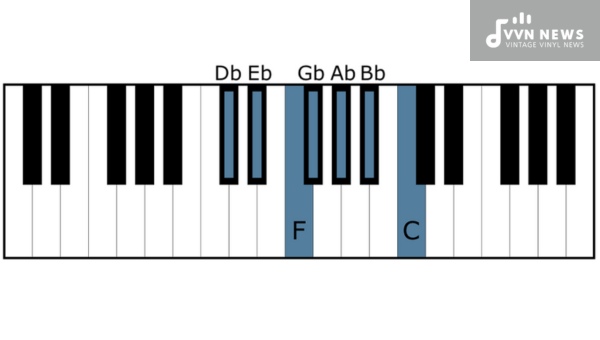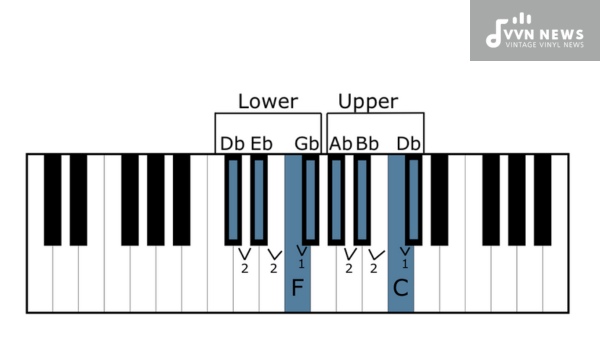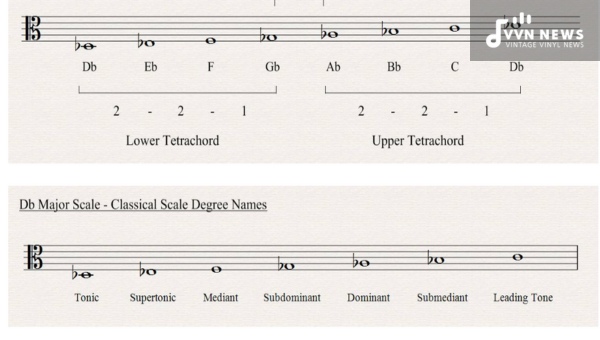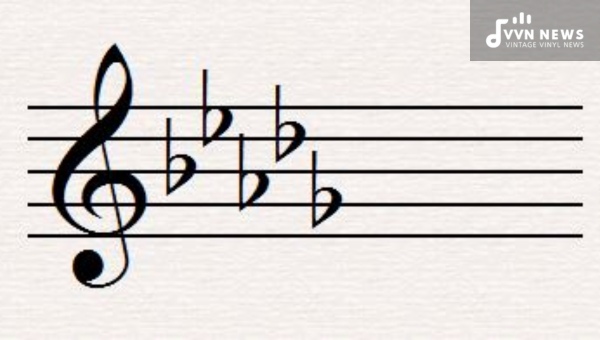In the grand orchestra of musical scales, the D flat Major scale holds a special place.
Often considered as the stepping stone to engaging with complex musical notes, this scale is your key to unlocking the vast universe of melodious compositions.
Whether you’re a budding pianist or a seasoned musician, mastering this scale can open up new avenues in your melodic pursuits.
Navigating your way around the D flat major scale may seem like a challenging task initially but you can rest assured it gets easier with time and practice.
It holds its unique position in music theory, noted for its specific sequence and arrangement of half and whole steps, which makes it distinct.
Understanding this scale not only adds another feather to your musical cap but also enriches your knowledge about the fundamentals of music theory.
How is the D Flat Major Scale Constructed?
The formation, or construction, of the D Flat Major Scale relies on a specific pattern of whole and half steps.
Interestingly, each major scale follows the same basic pattern making it universally applicable.
Here’s how it works:
- Start at D flat (Db). This is your ‘tonic,’ or starting note.
- Take a whole step to E flat (Eb).
- Understand that moving from Eb to F is also a whole step.
- Proceed with a half step from F to Gb.
- From Gb, take another whole step to reach Ab.
- Ascend a whole step from Ab to Bb.
- Move one more whole step from Bb to C.
- Finally, make a half-step move from C back up to Db.
The notation would look like this:
Db – Eb – F – Gb – Ab – Bb – C – Db
Whole and Half steps are represented as:
W – W – H – W – W – W – H
This sequence is essential for you when constructing and practicing the D flat major scale on your instrument of choice.
The mastery of this particular arrangement will help you excel in your musical journey.
Signature of the D Flat Major Scale

The signature of a musical scale forms an integral part of its identification.
Especially when it comes to the D Flat Major scale or any major scale for that matter, the key signature is your route to familiarize yourself with the unique pattern followed in that particular scale.
The key signature of the D Flat Major scale comprises five flats, namely Bb, Eb, Ab, Db, and Gb.
It’s important to note these as they guide you through any piece written in the key of D Flat Major.
Let’s break it down further:
- D flat (Db) – The root or tonic note of the scale.
- E flat (Eb) – The second note.
- F – Yes, It’s just a simple F since it doesn’t contain a natural note.
- G flat (Gb) – Our fourth note which is also flattened.
- A flat (Ab) – The fifth note in line.
- B flat (Bb) – Yet another flattened note that you will come across at sixth position.
- C – Here also no natural symbol follows C.
- And finally, another D flat, bringing you back to where you started.
With this sequence firmly implanted in your mind, approach any new piece with confidence and musical acuity; whether it be learning new songs or even composing your melodies.
Also Read: B Flat Minor Pentatonic Scale [Create Emotive Music In Minutes]
How to Play the D Flat Major Scale on the Piano?
The D flat Major scale originates from the root note D flat (Db). It comprises eight notes, also known as an octave, and is a part of the group of 15 major scales.
Learning this scale can add an intriguing twist to your piano repertoire.
To play the D flat major scale on the piano, your fingers need to hit these notes in sequence: Db – Eb – F – Gb – Ab – Bb – C – Db. Starting with your right hand, you would sequence it as follows:
- Begin playing with the 2nd finger (also known as the index finger) on Db.
- Continue with the 3rd finger (middle) for Eb.
- Now cross under with your thumb (1st finger) to play F.
- Follow up with your 2nd, 3rd, and 4th fingers for Gb, Ab, and Bb respectively.
- Finally, cross under again with your thumb to reach C and finish off with your 2nd finger on high Db.
Your venture into the world of music begins with mastering such intricate details.
Stride forward fearlessly toward enhancing your musical knowledge while taking one note at a time!
Deciphering the Degrees of the D Flat Major Scale

To gain a comprehensive view of scales, particularly the D flat Major scale, delving into its degrees is an unskippable step.
In music, degrees refer to the specific position of each note within a particular scale. They help categorize notes based on their sequence in the scale.
The D flat Major scale consists of seven distinct notes. Consequently, it features seven individual degrees. Let’s delve into each step:
- First Degree: The first degree (also known as Tonic) for this scale is Db.
- Second Degree: As we ascend on our musical journey in this scale, we reach Eb which is referred to as Supertonic or the second degree.
- Third Degree: F is the third note in our progression and holds the prestigious title of Mediant.
- Fourth Degree: The fourth degree (Subdominant) would be Gb.
- Fifth Degree: After that, we find Ab termed as Dominant, fitting perfectly into our beautiful assembly of notes.
- Sixth Degree: The penultimate station on this melodious journey through the D flat major scale is Bb or Submediant.
- Seventh Degree: Last but not least, we conclude with C entering itself as the leading tone.
This structure lends a unique melody to any composition that’s built upon it!
Assisting in recognizing chords and harmonies within songs you might already know and love, it manifests an entire spectrum of soulful melodies imparting the power to touch the audience’s hearts profoundly.
Also Read: A Flat Minor Pentatonic Scale [Unleash Subtle Tension In Your Music]
How is the D Flat Major Scale Represented in Different Musical Clefs?
The representation of the D flat Major scale differs distinctively across various musical clefs.
Let’s delve into how this beautiful scale displays itself on Treble Clef, Bass Clef, Alto Clef, and Tenor Clef.
Treble Clef
In Treble Clef, often utilized by high-range instruments like the violin or flute, and of course the right hand of pianists, the D flat Major scale starts on the fourth line from the bottom.
This line represents the ‘D’ note which is initiated through a flat symbol and transforms into ‘D flat’.
It is followed by E Flat (Space), F (5th line), G flat (space above the 5th line), A Flat (a ledger line above the 5th line), B Flat (space above the ledger line), C (2nd ledger line above staff), ending at D Flat represented by a third small ledger line.
Bass Clef
If you’re playing lower-range instruments such as the bass guitar or cello, you’ll primarily be reading in Bass clef.
In Bass clef, playing a D-flat Major begins on the fourth space from below; it’s symbolized as ‘D,’ which we have to modify as ‘D flat’ using a flat symbol.
The sequence is then carried forward with E Flat (3rd Line from below), F (3rd Space), G Flat (4th Line), and so forth until we hit the octave D-flat again.
Alto Clef
Alto clef isn’t as commonly used but still finds favor among some viola players and other mid-range instruments.
In this clef, our starting pitch for D-Flat lies on its second space from below.
This represents our baseline note ‘D’ which when flagged with a well-placed flat symbol turns into our desired ‘D flat’.
Succeeding notes are sequenced accordingly as we inch up the scale.
Tenor Clef
Last but not least, let’s discuss Tenor Clef. Again, not a widespread option, but it is used by instruments with a moderate range like the bassoon or trombone.
The sequence for the D-flat Major scale starts on the second line from the top in the tenor clef and is designated to produce ‘D’ that turns to ‘D flat’ using a flat symbol to complete the set in this clef.
Comprehending these permutations gives you the deft musical agility to maneuver across diverse instruments and their distinctive clefs.
It offers you an enriching experience of D Flat Major scale and sets you apart from others.
Also Read: G Flat Minor Pentatonic Scale [Interesting Tones For Your Music]
Relative Minor and Major of the D Flat Major Scale

When it comes to the D Flat Major scale, it’s essential to be mindful of its close relatives in music theory – the relative minor and major scales.
These scales grant you enhanced liberty in composition, improvisation, and interpretation.
B flat minor
The relative minor for a D Flat Major scale is B flat minor. Meaning, B flat minor shares the identical notes as its relative major, D Flat.
However, the tone series initiates from a different point – at B flat.
To approach this on the keyboard or piano:
- Begin at B flat.
- Proceed with white notes.
- Also, include E flat, A flat, and D flat.
This leads to the creation of an array of notes: B♭ – C – D♭ – E♭ – F – G♭ – A♭.
The commonality between B Flat Minor and D Flat Major should provide some ease in transitioning from one to another during compositions or performances.
F sharp/G♭ major
Contrary to relative minor scales that share the same notes but commence at different points are relative major scales which boast a similar root note but have a tableau of unique tones.
For example: F sharp (or G♭) major is denoted as parallel major for D Flat Major scale.
Being comfortable with these relative and parallel peers will not only enhance one’s competencies across multiple scales but also add a comprehensive depth when meditating on how varied tones can intermingle harmoniously within soundscapes bringing something beautiful into existence out from simple vibrations confined amidst octaves.
What Chords Comprise the D Flat Major Scale?
Diving deeper into the world of music, the harmony and richness of any piece of music often stem from chords.
But have you ever wondered about the chords that make up a D Flat Major Scale? They are key to creating a dynamic sound, setting varied moods, and making your melodies stand out.
D Flat Major Scale Chord Structure
To appreciate the diversity and exciting possibilities of this scale, you should become familiar with its structure. The D Flat Major Scale consists of seven notes:
- Db
- Eb
- F
- Gb
- Ab
- Bb
- C
Each note can be played in a chord form which further adds to the essence of this scale.
Also Read: D Flat Minor Pentatonic Scale [Spice Up Your Melodies Today]
Primary Chords in D Flat Major
The primary chords (commonly used) include:
- Db major: Db – F – Ab (First, or tonic chord)
- Gb major: Gb – B♭ – Db (Fourth, or subdominant chord)
- Ab major: Ab – C – Eb (Fifth or dominant chord)
These chords form the cornerstone for countless compositions across various genres.
Secondary Chords in D Flat Major
The secondary chords (less common) associated with this scale also play a crucial role in diversifying the musical palette:
- Eb minor: Eb – Gb- Bb
- F minor: F – Ab – C
- Bb minor: Bb – Db- F
- C diminished: C-Eb-Gb
D flat Major Scale is filled with an array of beautiful chords waiting to be explored and mastered.
These are more than just musical components; they serve as building blocks that can bring your musical creation to life, enabling your music to sparkle with authenticity, emotion, and depth.
Also Read: A Flat Minor Triad [Guide to Unusual Guitar Chords]
FAQs About D Flat Major Scale
Is the D Flat Major Scale different from other scales?
Yes, the D Flat Major Scale is unique due to its specific sequence of half and whole steps.
Why is understanding the D Flat Major Scale important?
Mastering the D Flat Major scale aids in expanding your understanding of music theory and enhancing your skills as a musician.
How would you describe the key signature of D Flat Major Scale?
The key signature of the D flat major scale has five flats namely B flat, E flat, A flat, D flat, and G flat.
What melody can be created with the D Flat Major Scale?
The melody created by a D flat major scale can vary significantly depending on the chord progression used.
What are some easy ways to remember the sequence of the notes in the D Flat Major scale?
Practice is key for remembering sequences in any musical scale. Regular and repeated finger exercises on your instrument help to embed this sequence in your memory.
Conclusion
Mastering the D flat Major scale is a noteworthy accomplishment in your musical journey.
Not only does it enhance your technical abilities, but it also opens up a world of more complex compositions for you to explore and understand.
Patience and perseverance will be your best allies in this endeavor, rewarding you with a richer understanding of music theory.
Dive deep into this melodic adventure and let the enchanting notes of the D Flat Major scale guide you to unchartered territories in your musical pursuits.








